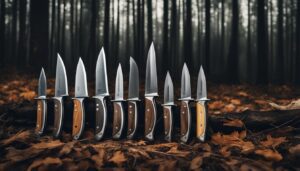When it comes to hunting knives, one crucial factor to consider is the blade length. The right blade length can make all the difference in terms of portability and ease of use.
A shorter blade offers increased maneuverability and makes it easier to carry your knife wherever you go. Whether you’re an avid outdoorsman or someone who needs a reliable tool on hand, finding a hunting knife with a compact length and portable size is essential.
At Texan Knives, we offer a range of hunting knives with varying blade lengths to suit your specific needs. From folding knives for everyday use to fixed-blade knives for heavy-duty tasks, we have the perfect blade length for optimal portability.
Key Takeaways:
- Blade length plays a crucial role in the portability of a hunting knife.
- A shorter blade offers increased maneuverability and ease of carry.
- Texan Knives offers hunting knives with varying blade lengths.
- Select the ideal blade length based on your specific needs and tasks.
- Consider the portability and compact size when choosing a hunting knife.
Exploring the Various Types of Outdoor Knives for Outdoor Adventures
In the world of outdoor adventures, having the right knife can make all the difference. There is a wide range of outdoor knives designed to meet the specific needs of different activities. Whether you are a hunter, survivalist, or simply enjoy spending time in the great outdoors, understanding the various types of knives available can help you choose the perfect blade for your adventures.
Fixed-Blade Knives
Fixed-blade knives are known for their strength and stability, making them a popular choice among outdoor enthusiasts. These knives have a solid, non-folding blade that provides exceptional durability and reliability. They are ideal for heavy-duty tasks such as chopping, cutting, and batoning wood. Fixed-blade knives are commonly used by hunters, campers, and survivalists who require a reliable tool that can withstand demanding conditions.
Hunting Knives
Hunting knives are specifically designed for hunters and feature a sharp, strong blade with a curved edge. These knives are perfect for field dressing and skinning game animals. They come in various shapes and sizes, allowing hunters to choose the one that best suits their specific needs. Hunting knives are an essential tool for any hunting expedition.
Folding Knives
Folding knives offer a convenient and compact option for outdoor enthusiasts. These knives have a folding mechanism that allows the blade to be safely tucked inside the handle when not in use. Folding knives are lightweight and easy to carry, making them a popular choice for everyday carry (EDC) and general outdoor tasks. They are versatile and come in different blade shapes and sizes to suit various needs.
Survival Knives
Survival knives are designed to be versatile and reliable in any survival situation. These knives typically have a strong, fixed blade with a full tang construction for maximum strength. Survival knives often feature additional tools such as fire starters, whistles, and serrated edges for cutting through rope or branches. They are an essential tool for those who enjoy venturing into the wilderness.
| Type of Knife | Key Features |
|---|---|
| Fixed-Blade Knives | Strength, stability, durability |
| Hunting Knives | Curved edge, ideal for field dressing and skinning game |
| Folding Knives | Compact, easy to carry, versatile |
| Survival Knives | Versatile, additional tools, reliable in survival situations |
Other types of outdoor knives include EDC knives, which are lightweight and designed for everyday use; multi-tool knives, which combine a knife with other essential tools; and fillet knives, which have long, narrow, flexible blades perfect for cleaning and preparing fish.
When choosing an outdoor knife, consider the activities you will be engaging in and the specific tasks you will need the knife for. Each type of knife has its own advantages and is suited to specific purposes. By understanding the different types of outdoor knives available, you can find the perfect blade to enhance your outdoor adventures.
Key Factors to Consider When Selecting the Perfect Hunting Knife
When choosing a hunting knife, it’s important to take several key factors into consideration. By carefully evaluating the purpose, size and weight, blade material, handle material, and budget, you can ensure that you find the perfect knife to meet your needs.
Purpose
First and foremost, consider the specific purpose for which you’ll be using the knife. Will you primarily be using it for hunting, survival situations, or everyday tasks? Different tasks require different types of knives. For example, if you’ll be skinning and field dressing game, a hunting knife with a curved blade may be the best choice. On the other hand, if you need a versatile tool for a variety of outdoor activities, a multi-tool knife may be more suitable.
Size and Weight
Next, think about the size and weight of the knife. A knife that is too large or heavy may be difficult to carry and handle, especially if you’ll be trekking long distances or navigating rugged terrain. Conversely, a knife that is too small may not provide enough cutting power for your intended tasks. Consider your physical abilities and the level of comfort you need when making your selection.
Blade Material
The material of the blade is another important factor to consider. Stainless steel is a popular choice for its corrosion resistance and durability. High-carbon steel, on the other hand, offers excellent edge retention and is ideal for heavy-duty tasks. Each material has its own set of strengths and weaknesses, so choose the one that best suits your needs and preferences.
Handle Material
The material of the handle plays a crucial role in the comfort and grip of the knife. Common handle materials include wood, rubber, and synthetic materials like G-10 or Micarta. Consider factors such as grip texture, durability, and how the handle feels in your hand. A comfortable and secure handle is essential for safe and efficient knife use.
Budget
Finally, determine your budget and select a hunting knife that fits within your price range. There are knives available at various price points, so it’s possible to find a high-quality knife that meets your needs without breaking the bank. Remember to prioritize quality and functionality over fancy features or unnecessary embellishments.
By carefully considering the purpose, size and weight, blade material, handle material, and budget, you can confidently choose the perfect hunting knife that will serve you well in all your outdoor adventures.
Essential Tips for Maintaining and Caring for Your Hunting Knife
Proper maintenance and care are crucial for ensuring the longevity and optimal performance of your hunting knife. By following these essential tips, you can keep your knife in top condition for all your outdoor adventures.
Cleaning
After each use, it’s important to clean your hunting knife thoroughly to remove any dirt, debris, and moisture that may be present. Pay special attention to the pivot area, blade, and handle. Use a mild soap or detergent and warm water to gently clean the knife, making sure to dry it thoroughly afterwards to prevent rust or corrosion. Avoid using harsh chemicals or abrasive materials that could damage the knife’s finish or integrity.
Sharpening
Regularly sharpening your hunting knife is essential for maintaining its cutting performance. Use a sharpening stone or a sharpening system specifically designed for knives to restore the blade’s edge. Follow the manufacturer’s instructions and use consistent, controlled strokes to achieve a razor-sharp edge. Remember to sharpen both sides of the blade evenly and maintain the knife’s original angle to ensure optimal cutting efficiency.
Lubrication
Lubricating your hunting knife is important for maintaining its smooth operation, especially if it has a folding mechanism. Apply a small amount of lubricant or oil to the pivot area and locking mechanism regularly to ensure they function properly. Be sure to use a lubricant that is specifically designed for knives, as other substances may cause damage or attract dirt and debris.
Storage
When your hunting knife is not in use, it’s essential to store it properly to protect the blade and prevent accidents. Ideally, store your knife in a dry and cool environment to minimize the risk of corrosion or damage. If your knife has a sheath or a protective cover, use it to keep the blade secure and prevent accidental injuries. Additionally, avoid storing your knife in a way that puts pressure on the blade or handle, as this could lead to deformation or other issues over time.
Routine Inspection
Regularly inspecting your hunting knife is crucial for identifying any signs of wear, damage, or rust. Take the time to examine the blade, handle, and other components for any abnormalities or issues. If you notice any problems, address them promptly to prevent further damage or potential safety hazards. Routine inspection allows you to catch and resolve problems early, ensuring that your knife remains in optimal condition for your outdoor adventures.
| Tip | Description |
|---|---|
| Cleaning | Thoroughly clean the knife after each use to remove dirt, debris, and moisture. |
| Sharpening | Regularly sharpen the blade to maintain its cutting performance. |
| Lubrication | Apply lubricant to the pivot area and locking mechanism to ensure smooth operation. |
| Storage | Store the knife in a dry, cool environment and use a sheath or protective cover. |
| Routine Inspection | Regularly inspect the knife for signs of wear, damage, or rust. |
Embracing the World of Knives and Outdoor Adventures
As I continue to develop my appreciation and understanding of knives, there are various ways I can further explore and deepen my connection to the world of outdoor adventures. One option is to attend knife skills workshops or classes, where I can learn new techniques and improve my knife handling abilities. These workshops provide valuable hands-on experience and the opportunity to learn from skilled instructors.
Another exciting option is to enroll in outdoor survival courses. These courses not only teach essential survival skills but also cover topics such as knife usage in different scenarios. Learning how to effectively use a knife in the wilderness can be crucial for outdoor enthusiasts and adventurers.
Connecting with the knife community is also a great way to expand my knowledge and share experiences with like-minded individuals. Online forums and social media groups dedicated to knives offer a platform for engaging discussions, sharing tips, and discovering new trends in the knife world.
For those who are passionate about customization, exploring the various customization options available can be a rewarding experience. From choosing unique handle materials to engraving personalized designs, customizing a knife allows me to create a one-of-a-kind tool that reflects my style and preferences.
Finally, expanding my collection of knives offers the opportunity to have the right tool for any job. From compact folding knives for everyday carry to specialized hunting knives for specific tasks, building a diverse collection ensures I’m always prepared for different outdoor adventures.
FAQ
What is the ideal blade length for a portable hunting knife?
The ideal blade length for a portable hunting knife depends on your specific needs and tasks. A shorter blade offers increased maneuverability and ease of carry, making it ideal for outdoor enthusiasts who require a compact and easily accessible knife.
What are the different types of outdoor knives available?
There are various types of outdoor knives available, including fixed-blade knives, hunting knives, survival knives, folding knives, EDC knives, multi-tool knives, and fillet knives. Each type is designed for different purposes and activities.
What factors should I consider when selecting a hunting knife?
When selecting a hunting knife, consider the tasks you’ll be using it for, the size and weight that will be comfortable to carry and use, the blade material that suits your needs, the handle material that provides a secure grip, and the knife that fits within your budget.
How do I maintain and care for my hunting knife?
Proper maintenance and care are essential for the longevity and optimal performance of your hunting knife. Clean your knife thoroughly after each use, regularly sharpen the blade, lubricate the pivot area and locking mechanism of folding knives, store the knife in a dry, cool environment when not in use, and regularly inspect for signs of wear, damage, or rust.
How can I further explore the world of knives and outdoor adventures?
You can further explore the world of knives and outdoor adventures by attending knife skills workshops or classes, enrolling in outdoor survival courses, connecting with the knife community through online forums and social media groups, exploring customization options, and expanding your collection to have the right tool for any job.





